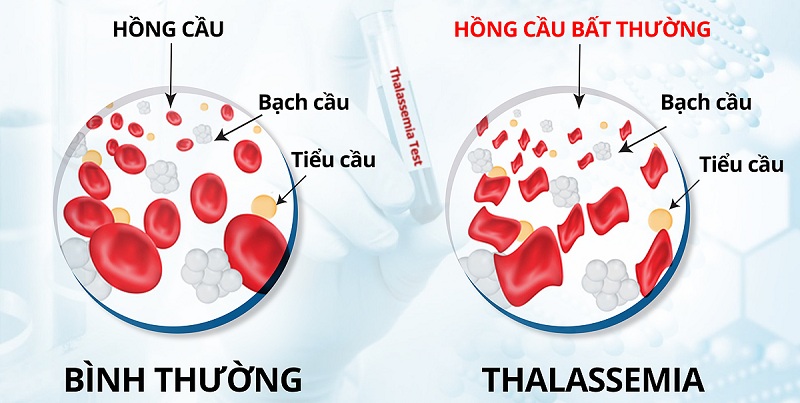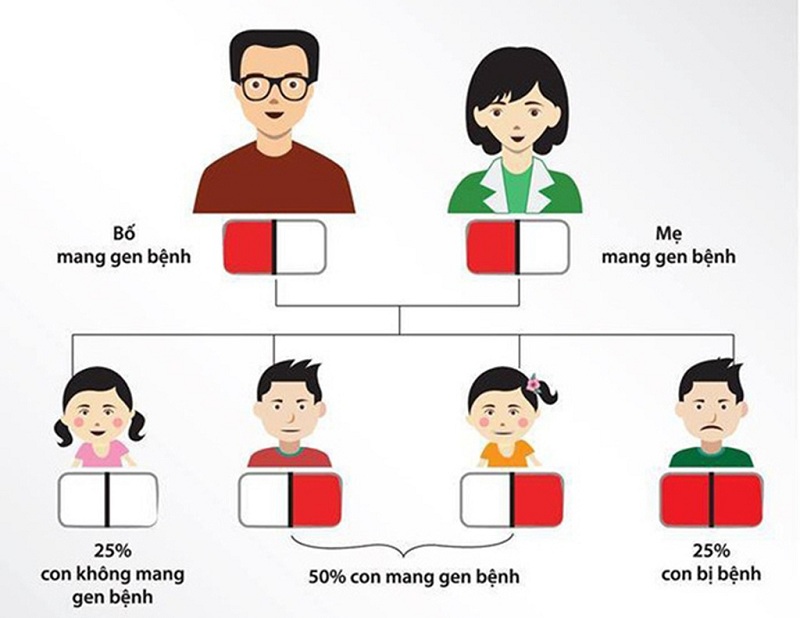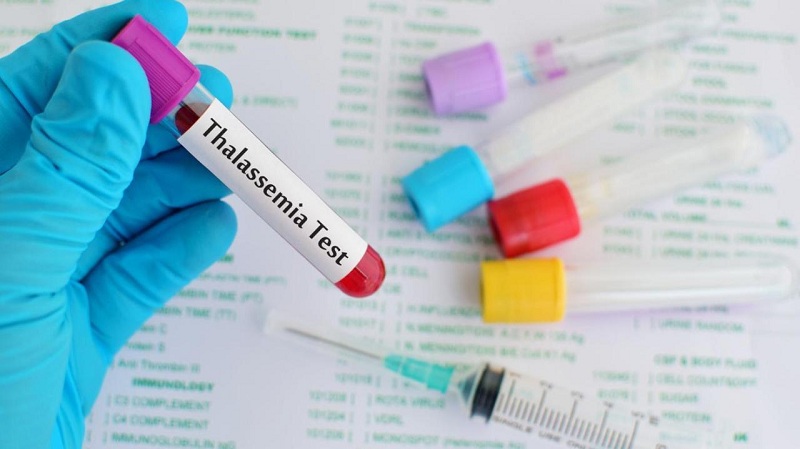Thalassemia is a genetic disease with a high incidence of common hematological diseases. If the congenital hemolytic disease is not detected and treated early, it can cause many dangerous complications due to anemia and iron overload. The following article will provide you with useful information about this dangerous disease.
Learn About Thalassemia
What is thalassemia?
Thalassemia, also known as Thalassemia, is inherited hemolytic anemia. This disease is quite common and has a high incidence in the world. According to statistics, the number of people carrying the gene for hemolytic anemia accounts for about 7% of the world population. In which, the proportion of couples with the risk of having a child with the disease or carrying the gene for the hemolytic disease is about 1.1%. Many people carry the gene that causes the disease but doesn't even know it. When detected, the disease causes severe physical, mental, health, and economic consequences for the affected family.
The congenital hemolytic disease is related to an abnormality in the structure of hemoglobin – a protein in red blood cells responsible for carrying oxygen. People with this disease will experience anemia due to the excessive destruction of red blood cells. The main manifestation of the disease is anemia and iron overload in all organs in the body.
Causes of thalassemia
Congenital hemolysis is an autosomal recessive genetic disease that can affect both males and females. It is caused by an abnormality or mutation in one or more genes involved in the production of hemoglobin. This causes the red blood cells to break down prematurely, which manifests as anemia.

In children, this disease is inherited from one of the parents or from both. If the child inherits the disease from one of the parents, the child's disease may be mild. If both parents have the disease, the risk of the baby having hemolysis is more serious.
What are the degrees of thalassemia?
The congenital hemolytic disease has 2 main types:
- Alpha – Thalassemia: is caused by mutations in one or more genes that synthesize the -globin chain
- Beta – Thalassemia: is caused by mutations in one or more genes that synthesize the β-globin chain.
Depending on the number of genes damaged, the hemolytic disease is divided into 4 different levels:
- Very seriously: this is the earliest manifestation of the disease. The fetus shows signs of edema from the time it is in the mother's womb. These cases often cause miscarriage before birth. Babies with this disease can die soon after birth due to severe anemia or fetal heart failure.
- Serious: there will be early and severe anemia when the child is less than 2 years old. Children have symptoms of severe anemia, enlarged liver, enlarged spleen, jaundice, retardation of physical, motor, and mental development. If not treated in time, the condition will get worse. People with this disease have short stature, protruding frontal bones, protruding occipital bones, flat noses, and protruding teeth.

- Moderate: children are born normally but usually show obvious anemia when the child is older than 6 years old. The disease tends to make anemia worse, and iron overload becomes increasingly severe.
- Mild: with mild and subtle anemia. The patient has no clinical symptoms and is only found to have the disease when accompanied by other diseases. In some cases, during pregnancy, surgery, or infection, thalassemia is obvious and then the patient is discovered to have the disease.
Is Thalassemia Curable?
Thalassemia is a dangerous genetic disease that directly affects the health and life of the patient. However, if detected early, hemophilia can be treated. Patients can still lead a normal life like any other human being.

According to modern medical advances, there are two ways to cure the disease.
The first is a hematopoietic stem cell transplant. Currently, this method has been implemented in many countries around the world, including Vietnam.
The second is gene therapy. However, this method is still being studied on volunteer patients.
Thalassemia will become dangerous when the disease is prolonged, causing complications such as iron overload, bone deformities, liver, spleen enlargement, anemia, growth retardation, or heart problems, … Therefore, early detection helps to better prevent complications caused by congenital hemolysis.
When Should Thalassemia Testing Be Performed?
Testing for thalassemia is an effective method to screen and prevent the disease for the next generation of children. Because it is a recessive genetic disease, the probability that a baby will have this disease if both parents carry the gene for hemolytic anemia is 25%. People with the disease can completely give birth to healthy babies if they are monitored, tested, and scrutinized before marriage. Therefore, testing for thalassemia is extremely necessary.

Specifically, people who should have a thalassemia test include:
- Those who are planning to get married should be tested for hemophilia before marriage to ensure the reproductive health and health of future generations.
- Couples who are planning to have children should be tested to screen for possible cases of the child having the disease.
- Pregnant women: testing for thalassemia during pregnancy is extremely necessary. Especially in the first 3 months of pregnancy, the mother needs to do tests to detect whether the fetus is sick or not so that the most timely measures can be taken.
- The husband of the pregnant woman has no history of thalassemia but the baby's blood test results are abnormal.
- People whose family members have the gene or are sick
- Couples with children with thalassemia.
- Children are sick, pale, underweight, yellow eyes, enlarged spleen, etc.
How Much Does Thalassemia Test Cost?
The cost of testing for thalassemia is a matter of great concern to many people today. There are many test methods to help diagnose hemolytic anemia such as:
- Peripheral blood cytology test
- Hemoglobin electrophoresis test
- DNA test
Therefore, depending on the method and facility, the cost of testing for thalassemia is different. Peripheral blood cell analysis and hemoglobin electrophoresis are two common methods, so you can easily perform them at medical facilities at a cost of several hundred thousand dongs. Meanwhile, DNA testing is a high-end testing technique, so the cost can be up to several million dongs. You need to do it at reputable and specialized medical facilities and centers where there is modern and capable medical equipment for genetic testing.
Prevention of Thalassemia
In order to prevent congenital hemolytic disease, each person first needs to understand this disease so that effective control and prevention measures can be taken. Here are some preventive measures:
Early screening and prevention
Couples planning to get married, couples intending to have children, and family members with thalassemia should receive genetic counseling and pre-marital testing. This is to prevent the birth of children between two people carrying the disease gene.

Prenatal screening
Prenatal screening helps detect disease early for the fetus. If both husband and wife carry the disease, the child has a 25% chance of having severe disease. Therefore, it is necessary to do prenatal testing and diagnosis by methods such as amniocentesis, chorionic villus biopsies, and genetic mutations to take timely measures.

Prenatal diagnosis includes the following steps:
- DNA test of parents, mutation of each person
- Amniocentesis or chorionic villus biopsies
- DNA test of amniotic fluid or placenta
- Advise pregnant women to terminate the pregnancy if the fetus is seriously ill
Proper diet and lifestyle
Besides preventive measures, building a healthy, reasonable diet also plays an important role in controlling the condition. What to eat when you have thalassemia? It is certainly a concern of many people.

According to doctors, patients should eat foods containing folic acid to help the body make new red blood cells. Full of nutrients, especially energy-boosting foods, fresh vegetables, and natural antioxidants.
In addition, for strong bones, it is necessary to ensure that the diet is adequate in calcium and vitamin D. Because patients with congenital hemolytic anemia often have iron overload, it is necessary to control the excess of iron.
Limit foods with high iron content and only use iron-containing medicines, vitamins, etc. when recommended by your doctor. In addition, patients should regularly exercise to improve their health.
To learn more information on our services and medical check-up package promotion, please visit here.
The site cannot and does not contain medical advice. The medical information is provided for general informational and educational purposes only and is not a substitute for professional advice. Accordingly, before taking any actions based upon such information. We encourage you to consult with the appropriate professionals.

 1900 1717
1900 1717 